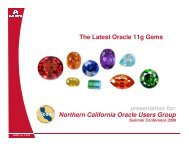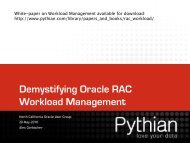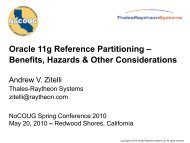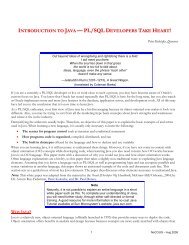Q&A with Juan Loaiza Stay Focused on the Five Steps ... - NoCOUG
Q&A with Juan Loaiza Stay Focused on the Five Steps ... - NoCOUG
Q&A with Juan Loaiza Stay Focused on the Five Steps ... - NoCOUG
You also want an ePaper? Increase the reach of your titles
YUMPU automatically turns print PDFs into web optimized ePapers that Google loves.
One memorable occasi<strong>on</strong> was presenting at a symposium<br />
arranged by Cary Millsap in his <strong>the</strong>nrole as head of Oracle’s<br />
System Performance Group (SPG) in Las Vegas (in 1998 or<br />
1999, I think). Eighty people attended my presentati<strong>on</strong> (<strong>the</strong><br />
maximum allowed) and several o<strong>the</strong>rs wanted in—what a<br />
great feeling!<br />
After <strong>the</strong> presentati<strong>on</strong>, Cary strolled up to me and casually<br />
remarked, “I think that was <strong>the</strong> best presentati<strong>on</strong> I ever<br />
saw.” Imagine hearing that from <strong>on</strong>e of your absolute heroes.<br />
I could have d<strong>on</strong>e anything in Las Vegas that night. But I<br />
didn’t.<br />
Fired up like that, it’s hardly surprising that I kept talking<br />
about <strong>the</strong> Oracle Wait Interface whenever I had <strong>the</strong><br />
chance.<br />
Surprisingly, I was still <strong>on</strong>e of <strong>the</strong> very few, if not <strong>the</strong> <strong>on</strong>ly<br />
<strong>on</strong>e, to talk about <strong>the</strong> Wait Interface at <strong>the</strong> IOUG c<strong>on</strong>ference<br />
in Orlando in 2001. The maximum number of attendees allowed<br />
into <strong>the</strong> room was 400 and still 150 more wanted in.<br />
That presentati<strong>on</strong> went extremely well. Cary Millsap was<br />
taking care of my slides, <strong>the</strong> audience was in a very good<br />
mood, and <strong>the</strong> whole thing rocked. In fact, a nice guy in a<br />
wheelchair in <strong>the</strong> fr<strong>on</strong>t<br />
“Gopal, Kirti, and<br />
Richm<strong>on</strong>d have<br />
made sure that<br />
<strong>the</strong>ir book c<strong>on</strong>tains<br />
essential details<br />
about <strong>the</strong> use of <strong>the</strong><br />
wait informati<strong>on</strong><br />
in Oracle 10g,<br />
while at <strong>the</strong> same<br />
time describing<br />
how to use it, what<br />
to look out for, and<br />
how to understand<br />
its output from<br />
Oracle 7.0.12 and<br />
up to <strong>the</strong> present.”<br />
The <strong>NoCOUG</strong> Journal<br />
of <strong>the</strong> room laughed<br />
so hard that at <strong>on</strong>e<br />
point his glass of water<br />
fell to <strong>the</strong> floor.<br />
During <strong>the</strong> same<br />
year, Gaja Krishna Vaidyanatha<br />
and Kirti wrote<br />
a fine performance<br />
book, Oracle Perform<br />
a n c e Tu n i n g 1 0 1<br />
(McGrawHill/Osborne,<br />
2001), in which<br />
Gaja introduced <strong>the</strong><br />
unforgettable phrase<br />
“Compulsive Tuning<br />
Disorder.” He should<br />
also be credited <str<strong>on</strong>g>with</str<strong>on</strong>g><br />
spreading <strong>the</strong> word<br />
about <strong>the</strong> Wait Interface<br />
<str<strong>on</strong>g>with</str<strong>on</strong>g> great enthusiasm.<br />
I didn’t participate<br />
at <strong>the</strong> recent IOUG<br />
c<strong>on</strong>ference in Tor<strong>on</strong>to<br />
(2004), but <strong>the</strong>re were<br />
a lot of presentati<strong>on</strong>s<br />
about <strong>the</strong> Wait Inter<br />
face. The Oracle Wait Interface has truly entered <strong>the</strong> mainstream<br />
of Oracle knowledge, and I must find o<strong>the</strong>r things to<br />
talk about.<br />
Cary Millsap and Jeff Holt of Hotsos have also written a<br />
very fine book, Optimizing Oracle Performance (O’Reilly,<br />
2003), <strong>on</strong> <strong>the</strong> topic of Oracle performance methodology<br />
(including a chapter <strong>on</strong> queueing <strong>the</strong>ory, which was invented<br />
in 1909 by a bored Dane, Agnar Erlang, who worked for <strong>the</strong><br />
ph<strong>on</strong>e m<strong>on</strong>opoly—<strong>on</strong>e day I’ll understand it).<br />
So <str<strong>on</strong>g>with</str<strong>on</strong>g> Oracle Wait Interface: A Practical Guide to Perfor-<br />
mance Diagnostics &<br />
Tuning fully (and I<br />
mean fully!) documenting<br />
<strong>the</strong> Wait Interface,<br />
its pitfalls and joys, and<br />
many tips and tricks, I<br />
think <strong>the</strong> topic is covered.<br />
This is why I have<br />
recently taken up talking<br />
to SQL Server audiences<br />
about <strong>the</strong> virtues<br />
of a Wait Interface. And<br />
you know what? They<br />
ask me whe<strong>the</strong>r <strong>the</strong>re’s<br />
a book available <strong>on</strong> <strong>the</strong><br />
topic.<br />
The timing of this book is perfect. Any o<strong>the</strong>r time would<br />
also have been perfect if it wasn’t for <strong>on</strong>e important detail:<br />
With Oracle Database 10g, Oracle (really Graham Wood, <strong>the</strong><br />
chief architect of <strong>the</strong> Manageability area in Oracle Development<br />
and ano<strong>the</strong>r technical reviewer of this book) is finally<br />
taking full advantage of <strong>the</strong> Wait Interface. Oracle is recording<br />
<strong>the</strong> right things, storing <strong>the</strong>m correctly in a repository, and<br />
using advisory services and o<strong>the</strong>r utilities to use <strong>the</strong> informati<strong>on</strong><br />
to its fullest.<br />
Gopal, Kirti, and Richm<strong>on</strong>d have made sure that <strong>the</strong>ir<br />
book c<strong>on</strong>tains essential details about <strong>the</strong> usage of <strong>the</strong> wait informati<strong>on</strong><br />
in Oracle Database 10g, while at <strong>the</strong> same time<br />
describing how to use it, what to look out for, and how to<br />
understand its output from Oracle 7.0.12 and up to <strong>the</strong> present.<br />
A very impressive piece of work.<br />
The promise of all this is that optimizati<strong>on</strong> can be automated,<br />
but that’s a bit out in <strong>the</strong> future. Until such time when<br />
we can all safely forget about performance problems, this<br />
book ought to be <strong>the</strong> preferred reference <strong>on</strong> this topic.<br />
If it weren’t for <strong>the</strong> fact that I get a copy for free, I would<br />
buy this book.<br />
About <strong>the</strong> Authors<br />
“Until such time<br />
when we can all<br />
safely forget about<br />
performance<br />
problems, this<br />
book ought to be<br />
<strong>the</strong> preferred<br />
reference <strong>on</strong> this<br />
topic.”<br />
Richm<strong>on</strong>d Shee is a senior database architect for Sprint.<br />
Kirtikumar Deshpande is a senior Oracle database administrator<br />
for Veriz<strong>on</strong> and <strong>the</strong> coauthor of Oracle Performance<br />
Tuning 101. K. Gopalakrishnan is a principal c<strong>on</strong>sultant for<br />
Oracle India and <strong>the</strong> author of Oracle Database 10g Real Applicati<strong>on</strong><br />
Clusters Handbook. <br />
Mogens Nørgaard (mno@miracleas.dk) is <strong>the</strong> CEO of Miracle<br />
A/S, a database knowledge center and c<strong>on</strong>sulting/training company<br />
based in Denmark, and is <strong>the</strong> co-founder and “fa<strong>the</strong>r<br />
figure” of <strong>the</strong> Oak Table network. He is a renowned speaker at<br />
Oracle c<strong>on</strong>ferences all over <strong>the</strong> world and organizes some highly<br />
respected events through Miracle A/S, including <strong>the</strong> annual<br />
Master Class and <strong>the</strong> Miracle Database Forum. He is also <strong>the</strong><br />
co-founder of <strong>the</strong> Danish Oracle User Group (OUGKD) and<br />
was voted “Educator of <strong>the</strong> Year” in Oracle Magazine’s Editor’s<br />
Choice Awards, 2003.








